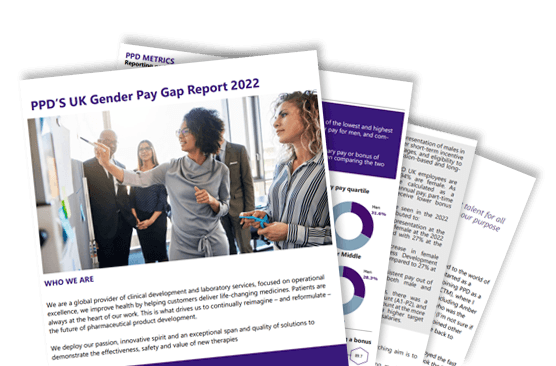
PPD UK 2022 Gender Pay Gap Report
Who we are
The PPD™ clinical research business of Thermo Fisher Scientific is a global provider of clinical development and laboratory services, focused on operational excellence, we improve health by helping customers deliver life-changing medicines. Patients are always at the heart of our work. This is what drives us to continually reimagine – and reformulate – the future of pharmaceutical product development.
We deploy our passion, innovative spirit and an exceptional span and quality of solutions to demonstrate the effectiveness, safety and value of new therapies
Our gender pay gap report
We are publicising this report pursuant to the Equality Act 2010 (Gender Pay Gap Information) Regulations 2017. These regulations require all UK – based employers with 250 or more workers to publish annually specific metrics on their gender pay gap on their company website and the U.K. government website.
The report shows the difference in average pay between women and men, looking at all levels across the company in the U.K. It also examines the distribution of males and females throughout the organisation in terms of pay levels.
As with the previous reports, it’s important to note that a gender pay gap is not the same as equal pay. Equal Pay is the concept of paying men and women equally for equivalent work. A gender pay gap report is not a pay audit and does not report on equal pay as it does not compare pay between men and women for specific roles.
This report also indicates how our results have changed from the report published in 2021 and provide additional commentary to aid under- standing.
Metrics
Reporting period: 6 April 2020 – 5 April 2021
Statistics
The median gender pay and bonus gap is calculated by taking the midpoint of the lowest and highest
bonus or pay for women and the midpoint of the lowest and highest bonus or pay for men, and com-
paring the two results.
The mean gender pay and bonus gap is calculated by summing up all the ordinary pay or bonus of women and dividing by the number of women, doing the same for men, and then comparing the two results.


Key takeaways
- Our mean and median hourly pay gap has decreased by 2.7% and 2.5% respectively to our 2021 report. The overall company breakdown of males and females remain static.
- There has been limited movement across the 4 pay quartiles.
- 91.3% of our female employees received a bonus versus 89.9% of males within the reporting year.
- Our pay gap continues, as in previous years, to be influenced by the relatively disproportionate representation of males in roles with highest hourly pay rates.
- Our mean and median gender pay gaps of 9.1% and 5.5% respectively, continue to be lower than the national mean and median hourly gender pay gaps of 15.4% and 14.9%, respectively.
- The 2022 reporting year Mean Gender Bonus Pay Gap of 46.2% and Median Bonus Pay Gap of 26.9% is an improvement from the 2021 report. The current gap is primarily attributable to:
- A disproportionate representation of males in jobs/levels with higher short-term incentive target bonus percentages, and eligibility to participate in commission-based and long-term incentive plans.
- In addition, 15% of our UK employees are part-time, of which 94% are female. As bonus payments are calculated as a percentage of eligible annual pay, part-time employees tend to receive lower bonus payments.
- The improvements we’ve seen in the 2022 report are primarily attributed to:
- An increase in female representation at the VP/SVP level, 45% were female at the 2022 snapshot date, compared with 27% at the 2021 snapshot date.
- There has been an increase in female representation in Business Development roles, 50% were female compared to 27% at the 2021 snapshot date.
- There was also a more consistent pay out of BD commission across both male and female.
- At the more junior levels, there was a reduction in female headcount (A1-P2), and an increase in female headcount at the more senior levels which have a higher target bonus and generally higher salaries.
Key actions
We recognize that there are contributing factors to the gender pay gap, and the overarching aim is to address barriers or biases that may contribute to it.
This goal aligns with the company’s wider global strategy to remain competitive in attracting, motivating, retaining and developing industry-leading talent for all roles regardless of gender, age, race, religion, dis- ability or any other form of discrimination.
We will continue to address the gender pay gap through these key initiatives, among others
- In 2021, we:
- Continued ‘Creating an Inclusive Culture’ workshop for people managers which discusses barriers to inclusion such as bias
- Two female executive leaders have been added to the Talent, Culture and Inclusion Committee
- Expansion of Women’s Empowerment Network from Cambridge to include all EMEA employees
- Talent management:
- Continued promotion of Global Mentoring Programme under the WEN umbrella. The programme now has 1,500 mentors and mentees
- Analysis:
- Continuously reviewed U.K. benefits provisions with the aim of enhancing policies to support women and eliminate barriers to internal mobility
- Reward:
- Launched the Global Remote Work policy to allow employees more flexibility
- Introduced enhanced maternity policy in January 2022
We are committed to recruiting, developing and retaining the best talent for all roles to drive our performance, deliver for our clients and achieve our purpose and mission
We confirm that our data has been calculated according to the requirements of the Equality Act
2010 (Gender Pay Gap Information) Regulations 2017
Julia James
General Counsel
